Veiled Chameleon for sale
Veiled Chameleons are, without a doubt, one of the most popular species in the reptile trade (and a great pet for beginners). This is thanks, in large part, to their ease of care and beautiful coloration.
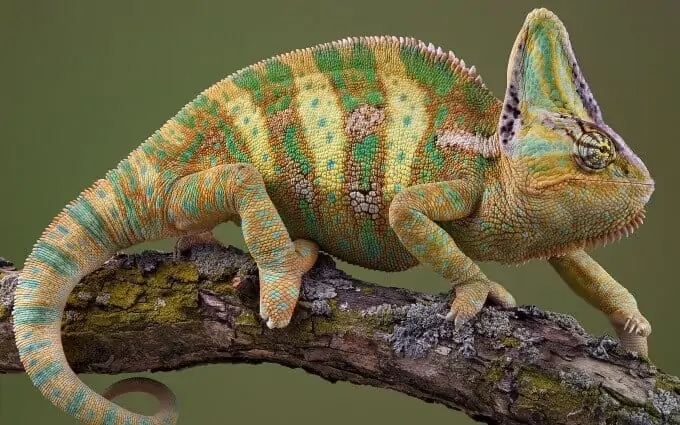
The body is typically covered in bands of yellow, green, and brown. But like many chameleon species, this kind can change color on a dime. These lizards are known to flash some beautiful colors!
In terms of care, Veiled Chameleons are quite manageable. They tolerate a decent range of temperatures and will thermoregulate whenever they need some adjusting.
Stable humidity levels are important, too. This species needs at least 50 percent humidity at all times. Luckily, that’s an easy threshold to meet with regular misting.
Contrary to popular belief, Veiled Chameleons don’t like to be held. They can get stressed out when handled too much.
This type of chameleon also prefers to live alone. In a good environment, these chameleons will be still and calm. But in the presence of others, aggressive behaviors can come out!
Meller’s Chameleon
Hailing from mountainous regions of East Africa, the Meller’s Chameleon is a gorgeous reptile that can be a bit difficult to care for. Most of the pet Mellers you see in the trade today are wild imports. These lizards can take a while to acclimate to life in captivity, presenting a challenge for new and novice reptile enthusiasts.
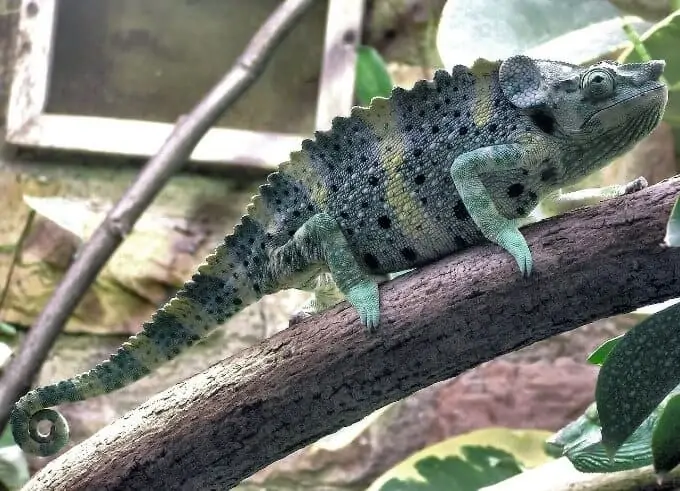
The good news is that Meller’s Chameleons will show their stress or discomfort through their coloration. When happy and healthy, these lizards take on colors of bright yellow in green. But the lizard will dull its color or develop black spots when it feels threatened or anxious.
Expert Tip: This is the species we recommend for experienced owners who want to mix things up a bit. This chameleon has a different look than many others, making them quite fun to observe.
Panther Chameleon for sale
Panther Chameleons are colorful creatures that can take on a spectrum of vibrant hues. These lizards change their color to communicate with one another and absorb radiant heat. You might see them take on shades of turquoise, red, green, and more.
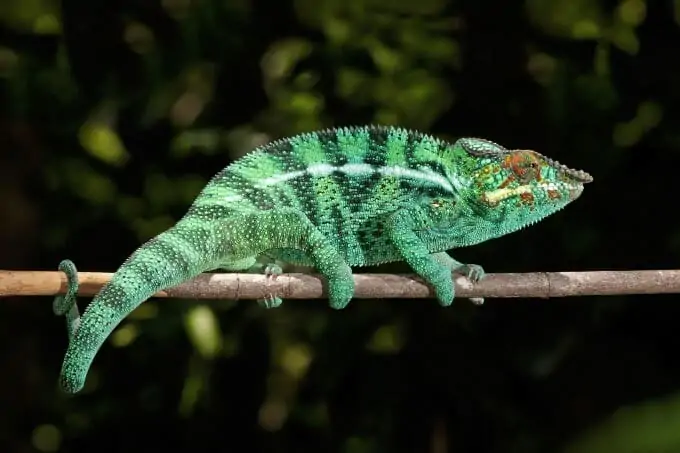
Generally, males are more colorful than females. But, female Panther Chameleons can alternate between beautiful shades of pink and high-contrast tones of red or black. In most cases, the color change in females all depends on their receptiveness to breeding.
There’s a noticeable size difference between males and females, too. Males can reach lengths of up to 20 inches while females usually stop growing after 12 inches.
Panther Chameleons are solitary animals. They can get territorial with others, so they prefer to live alone.
This chameleon species isn’t too keen on handling, either. While not particularly aggressive, excess handling could lead to unwanted stress.
Four-Horned Chameleon for sale
Despite what their name would lead you to believe, Four-Horned Chameleons don’t always have four horns on their skull. Some can have a single horn or sport as many as six! Either way, their horns are the most defining feature of this species.
Unlike other popular types of chameleons in the trade, this kind is more muted when it comes to color. They usually have more natural tones of red and yellow.
Their scale pattern is more varied as well. You might see some accents of purple, orange, or blue. But, most of the body is natural-looking for easy camouflage.
Four-Horned Chameleons are best for reptile enthusiasts with some experience. The reason for this is the strict demands of this species.
They require very warm and humid environments like their native habitats in Cameroon. They don’t tolerate a ton of deviation, so you must stay on top of living conditions to keep them happy.
Oustalet’s Chameleon
Oustalet’s Chameleons are one of the largest species available. Males can reach maximum lengths of about 27 inches! Females only get about half that size, but they can still be hard for inexperienced owners to manage.
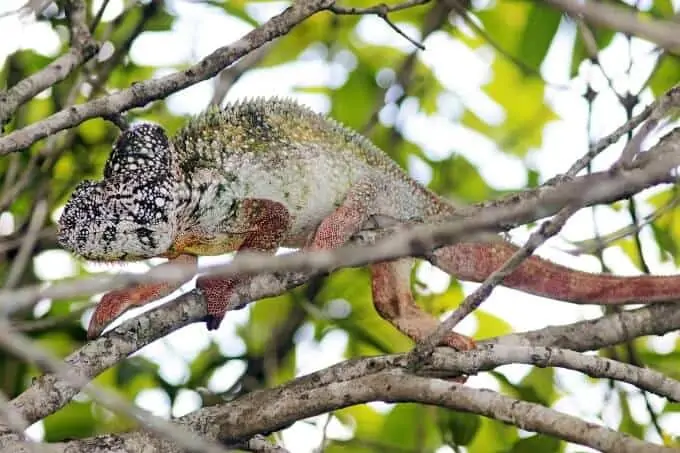
Beyond their size, Oustalet’s Chameleons can be a challenge due to their environmental needs. Not only do they need large enclosures, but they need a lot of humidity.
This type of chameleon prefers humidity levels to be at 70 percent or higher. They come from humid forests in Madagascar, so this preference is not surprising.
Many owners shower their chameleons with warm water for an hour every week. This can help keep the lizard hydrated. However, it won’t make up for low humidity levels in their enclosure.
These lizards need a well-planted enclosure with plenty of moisture-absorbing substrates. Regular misting and relatively warm temperatures are a must, too.
Carpet Chameleon For sale
The Carpet Chameleon gets its name from the color markings all over its body. All specimens can have spots, stripes, and circles. But, those beautiful markings intensify in gravid females. Some females can have so much intricate detail on their bodies that they resemble an Oriental carpet!
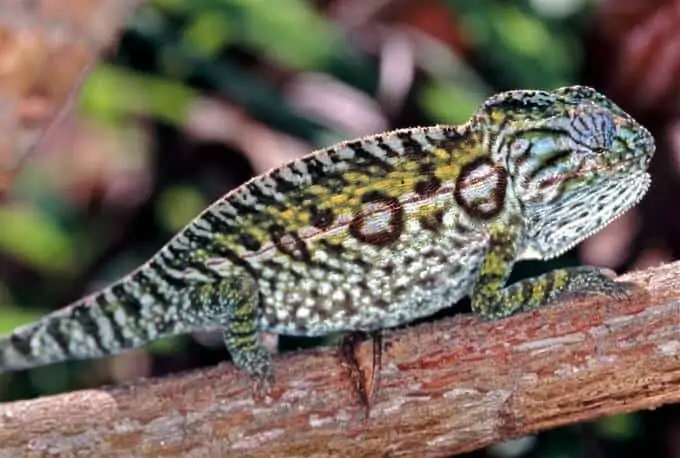
Females are more ornate than males, which is unusual in the animal world. As a result, many owners prefer to keep females instead of males.
Generally, males will display shades of green, white, and yellow. You might also see some black markings here and there.
This is a smaller chameleon species. Most will reach adults lengths between six and ten inches. Thanks to their small size, Carpet Chameleons don’t need a massive enclosure.
That said, they still need plenty of decorations. This type comes from Madagascar. They’re usually found in lush rainforests filled with vegetation. While they can also come from mountain and desert regions, most captive Carpet Chameleons prefer a forest-like environment.
Expert Tip: This is actually one of our personal favorites. This pet chameleon has a very textured look that you need to see in person to appreciate!
Senegal Chameleon
Native to West Africa, the Senegal Chameleon is not a species you’ll find in lush rainforests. These lizards come from dryer savannas. They’re used to more sun exposure and grassy environments.
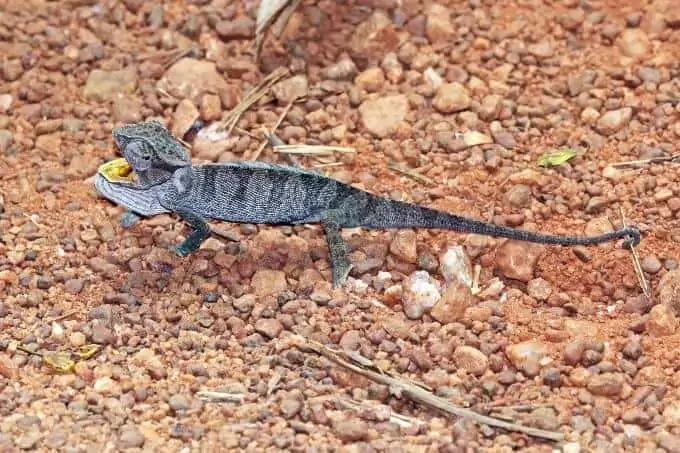
In captivity, a similarly decorated enclosure is required. These lizards need plenty of vertical climbing space, proper air circulation, and a good amount of humidity. Senegal Chameleons stay hydrated by drinking off of wet leaves and taking advantage of the moisture in the air. So, proper misting or an automatic dripping system is important.
Senegal Chameleons are on the smaller side. They reach a maximum length of about eight inches.
Unlike other species, Senegals usually don’t have any horns. They’re not sporting a sizable crown either. But, they do have other iconic chameleon traits. These include the joined toes, conical eyes, and long tongue.
In terms of color, Senegal Chameleons can vary quite a bit. Most have shades of green with subtle banding and spots. Some may take on a gray or bluish tone.
Jackson’s Chameleon For Sale
The Jackson’s Chameleon is another popular species with a distinct look. Its most identifying feature is its horns. Male specimens have three horns on their face. Two are located below the eyes while a larger horn sits on the nose.
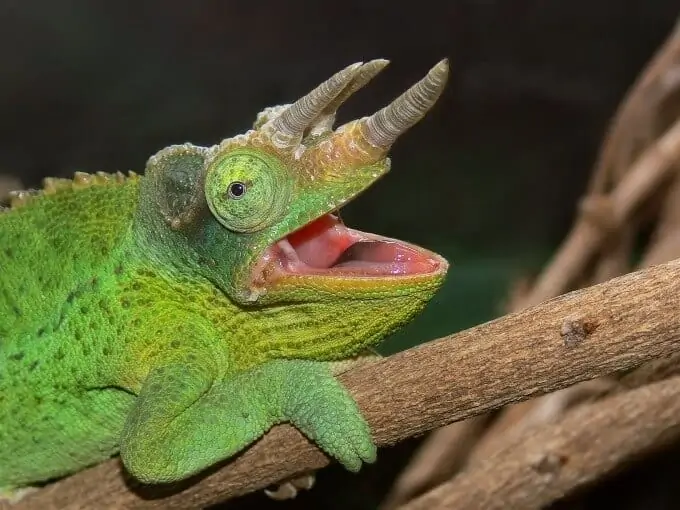
These chameleons also have thick spiny ridges running along the entire back.
When first born, these lizards take on a brown color. But, they quickly develop their signature green hue after several months. Males are more colorful than females. Green is the primary color, but you may also see splashes of blue or yellow. Those colors are most common around the face.
Jackson’s Chameleons are very territorial. They should be housed alone to prevent any aggressive behavior or fighting. These lizards also don’t like handling.
Once you set up their new home, you should only handle them when you need to clean the enclosure. Even then, you need to be gentle and quick to avoid undue stress.
Fischer’s Chameleon For Sale
The Fischer’s Chameleon is a species that the scientific community is still learning about. There are many chameleons in the pet trade today that are mistakenly labeled as Fischer’s or Fischer’s subspecies. However, true Fischer’s Chameleons are quite rare.
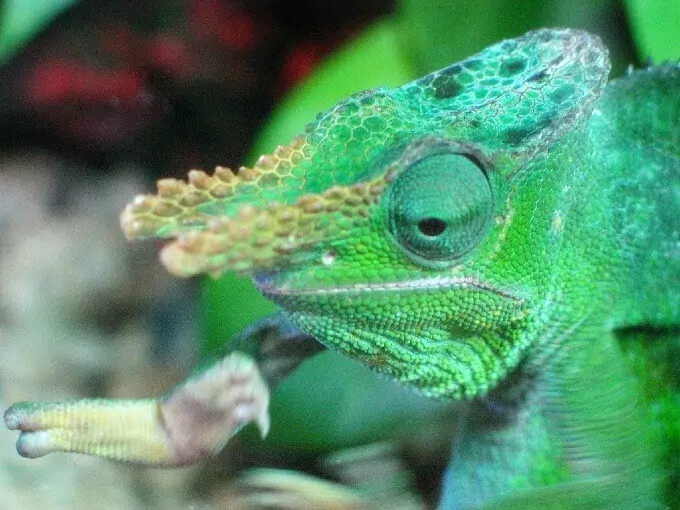
The best way to identify this species is to take a look at its color pattern and face. These lizards take on a vibrant green color. They have tall, rounded backs and a spine lined with soft spikes.
Accompanying the base color are vertical stripes of white. You may also see some subtle patches of light blue.
On the face, Fischer’s Chameleons have a distinct horn. Many refer to the horn as a tubercle instead because of its texture. The horn is covered in bumpy scales. They provide a texture that’s very similar to tree bark.
Fischer’s Chameleons only get about 11 inches long at the most, making them one of the smaller chameleon species.
Flap-Necked Chameleon
Here’s a chameleon species that does very well in captivity. The Flap-Neck Chameleon can tolerate a range of conditions. They like temperatures in the upper 70s and relatively moderate humidity levels. As long as you stick within the accepted ranges, these lizards will have no problem staying healthy.
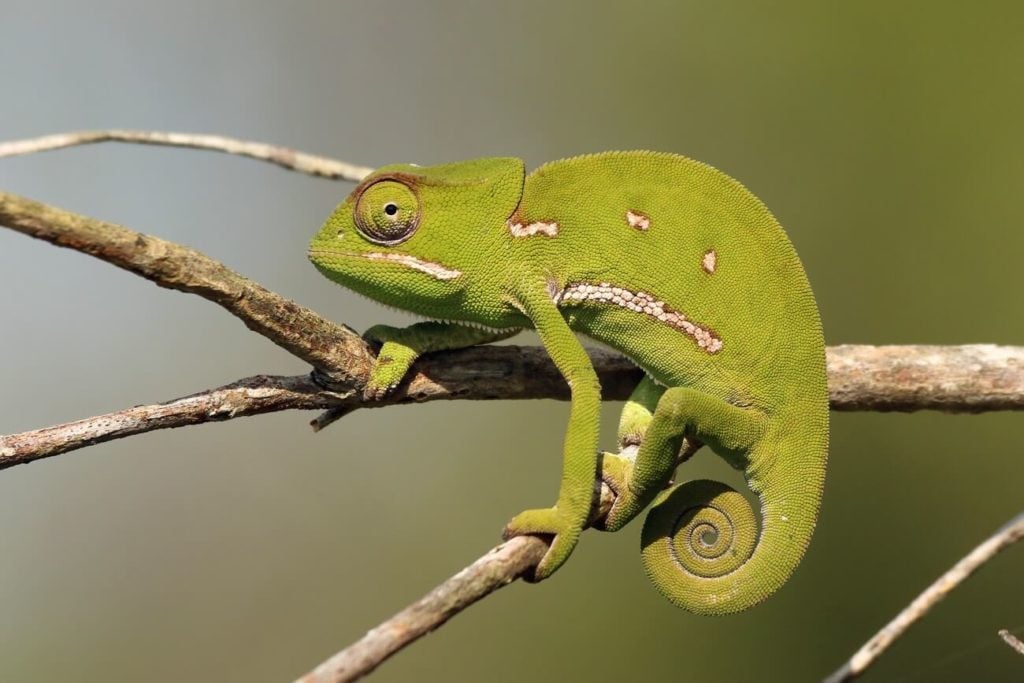
There are several Flap-Neck subspecies available. But, most of them are going to stay under a foot in length. As a result, they’re very manageable in terms of enclosure size.
Like most chameleons, this species prefers a good amount of vertical climbing space. They like moisture-rich substrates and ample vegetation, too.
This type of chameleon comes from tropical regions in South Africa. Coloration can vary quite a bit between the subspecies. However, most are going to have a bright green base color. Some subspecies will be solid-colored while others have distinct markings of white and black.
Pygmy Chameleons For Sale
One of the most unique chameleon species available is the Pygmy. As you can guess from their name, these lizards are very small! Most adults will only reach lengths of 3.5 inches at most. They can fit in the palm of your hand!
This species is quite muted in terms of coloration. Rather than the bright greens and yellows that other species have, Pygmies blend in better with the forest floor. They are covered in shades of brown. You might see brighter hues during courtship, but brown is the norm.
The cool thing about Pygmy Chameleons is that you can keep them in groups. They will tolerate some company. But, you have to plan accordingly. You should never keep more than one male in the same enclosure. Otherwise, territorial behavior will come out.
Conclusion
We hope you enjoyed this list of the best types of chameleons you can keep as pets. We had a ton of fun putting it together!
There’s a reason why these lizards are so popular. Their unique look, peaceful temperament, and ease of care (most of the time) makes them a no-brainer for beginners and experienced owners alike.
If there are any other species that you think deserve a spot on the list, feel free to send them over! There are so many to choose from that we tried to keep things brief, but if you make a good argument we might add some more!
